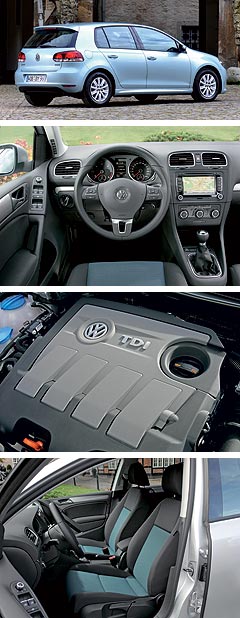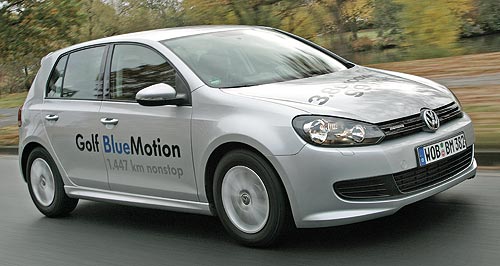Make / Model Search
Future models - Volkswagen - Golf - BlueMotionFirst Drive: True BlueMotion Golf Oz-boundChange of heart: The Golf BlueMotion will now be coming to Australia. Volkswagen to pitch two-pronged eco strategy for its popular small car from mid-201128 Sep 2010 By BYRON MATHIOUDAKIS in GERMANY VOLKSWAGEN will join the growing number of manufacturers offering high-economy variations of popular models Down Under with the introduction of the Golf BlueMotion in about May next year. Probably beating the most frugal Golf ever to the Australian market in the first half of 2011 will be a reskinned Passat to be unveiled at this week’s Paris Motor Show and the second-generation Touareg luxury SUV. Although these will not be full eco-hero models, they will employ some of the efficiency improvements found in the Golf BlueMotion, including idle-stop technology, as part of an option pack known as ‘BlueMotion Technology’ that will be rolled out from next year. The Golf BlueMotion – a distinct model, minus the ‘Technology’ moniker – promises to be the most economical vehicle of its size in Australia, edging out the latest Toyota Prius in the combined fuel consumption average stakes by the smallest of margins – 3.8L/100km against the petrol-electric hybrid’s 3.9L/100km figure.  Only the smaller Ford Fiesta Econetic will have lower consumption, at 3.7L/100km. Only the smaller Ford Fiesta Econetic will have lower consumption, at 3.7L/100km.Along with the idle-stop system, the Golf BlueMotion’s impressively light appetite for diesel is aided by low-rolling-resistance tyres, battery regeneration technology that uses braking energy to recharge the battery, revised gearing for optimised fuel consumption, a multi-function computer display providing gearchange points, lighter alloy wheels, and improved aerodynamics thanks to a specially designed body kit and lowered suspension settings. Despite all these measures, the Prius still emits fewer harmful nitrogen oxide particles as well as less carbon dioxide emissions – the latter registering at 89 grams per kilometre against the BlueMotion’s 99g/km. Under the Golf’s bonnet is a variation of the 1.6-litre 77TDI common-rail four-cylinder turbo-diesel engine that the Mk6 Golf range received in Australia in late-2009, producing 77kW of power at 4400rpm and 250Nm of torque from 1500 to 2500rpm. In the standard Golf 77TDI, it delivers 4.9L/100km and 129g/km – highlighting just how much difference the BlueMotion gear makes. Little wonder it was named Green Car of the Year by UK magazine What Car? For now, Volkswagen only offers a specially designed five-speed manual gearbox in the Golf BlueMotion, but we hear a DSG dual-clutch gearbox is in the pipeline and may just be ready in time for the Australian release in mid-2010, though nobody at Volkswagen is saying. Pricing has not yet been revealed, but going on the UK version released earlier this year, the Golf BlueMotion should command a premium of between $1000 and $1500 in Australia over the $27,490 77TDI Trendline model on which it is based – making it about $10,000 cheaper than the Prius. The Golf BlueMotion was not offered in Australia earlier because this country was deemed by Volkswagen AG to be unsuitable since hotter ambient operating temperatures and increased usage of air-conditioning puts heavy loads on a vehicle’s electrical system, which would often result in the idle-stop function turning off, for instance. However, Volkswagen Australia spokesman Karl Gehling said there had been a change of heart. “BlueMotion will perform most of the time as it is designed to, and there are no problems in terms of the vehicle’s operations since the switch-off system is there to ensure that passenger comfort is maintained,” he said. Confusingly, there will be a separate Golf BlueMotion Technology pack model available from around mid-year as well, with cherry-picked efficiency-enhancing measures like idle-stop. But why is Volkswagen bothering with the ‘half-strength’ BlueMotion Technology model for the Golf when it will also have the ‘full-strength’ model? “Because the Golf BlueMotion is manual-only, while the BlueMotion Technology package will be available on other Golf models like the 103TDI with DSG,” said Mr Gehling. The BlueMotion Technology pack is therefore expected to take the lion’s share of sales, leaving the super-eco version to act as a halo model extolling the progress VW is making to reduce harmful emissions and increase fuel economy. Drive impressions: CLEARER blue skies may be the welcome upshot of the arrival of the Golf BlueMotion models to Australian shores next year, but Volkswagen’s naming policy might result in buyers being confused about what it all means. Basically, the upcoming Golf BlueMotion and Golf BlueMotion Technology are like two types of milk – ‘No Fat’ and ‘Semi Skimmed’ respectively. The BlueMotion badge with ‘Technology’ added to it means you don’t get the ‘Full Fat’ benefits of going for the greener of the two cars (the one simply labelled ‘BlueMotion’). Having more words means less benefits, while less words equals more for the environmentally aware buyer… Get it? And then there’s the ‘Blue’ bit – blue is the new green it seems, at least in Germany, anyway. Why ‘blue’? Blue oceans, blue sky and all that stuff obviously equates to cleaner environmental living, according to our helpful Volkswagen BlueMotion expert. So blue it is… for green. Anyway, get your head around that and, when it all comes down to it, what we are left with are two distinct Golf models that look, feel and drive virtually the same as the regular 77TDI and 103TDI that the BlueMotion and BlueMotion Technology are respectively based on. Driven in the most unAustralian conditions – smooth and scarcely populated German Autobahns on a quiet Sunday – nothing about the way either Golf performed led us to believe that these BlueMotion vehicles are somehow different from their siblings. As with all Mk6 Golfs, the strong and well-made body ensconced a quality, sober and utterly accommodating interior of almost flawless ergonomic design. Behind the wheel, the steering felt no different, and nor did the performance from the respective 1.6- and 2.0-litre four-pot turbo-diesel powerplants. The former needs to be revved hard while the latter is a more satisfying source of mechanical refinement and response. Only when we lobbed behind a line of standing traffic did one of the myriad of eco measures noticeably kick in, as the smooth and relatively quiet TDIs stopped the moment there was no motion. The silence was golden. No distant diesel murmur. No low-frequency vibration from the wheel, pedals or seat cushion. Just the sound of traffic polluting quietly all around. As soon as the rested foot pressed down on the light clutch and first gear was selected, the TDI would spring back into life. We tried to beat the starter with a ham-fisted forward push of the lever, but the electronics were already on high alert. And when we inadvertently stalled after a wrong ratio was selected, the idle-stop system fired it up again instantly. Impressive. Attempting personal autobahn V-maxes in de-restricted zones didn’t much dent fuel economy, either, with the No-Fat BlueMotion sitting pretty at around 5.5L/100km while the Semi-Skimmed was in the low-to-mid 7s overall. In summary, what we have here is a perfectly normal and respectable Golf, behaving totally as expected, but demanding less from your fuel tank while taxing your aural senses somewhat less when sitting still in traffic. There is none of the visual earnestness of a Toyota Prius, so hardly anyone will even be aware of how caring you really are, but there is plenty on the flipside. The Golf BlueMotion eco hero model should cost up to $10K less than even a base Prius – let alone the BMW 118d, another greenie warrior – yet it offers virtually as much space and practicality, while the $5K price penalty over a Ford Fiesta Econetic is more than outweighed by the larger and more refined packaging – as well as the VW badge. We like a lot – as long as you can get your head around that silly badging…  All future models Alfa Romeo Alfa Romeo Abarth Abarth Alpine Alpine Alpina Alpina Audi Audi Aston Martin Aston Martin BMW BMW Bentley Bentley Chery Chery Brabham Brabham Chrysler Chrysler Chevrolet Chevrolet Cupra Cupra Citroen Citroen DS DS Dodge Dodge Fiat Fiat Ferrari Ferrari Foton Foton Ford Ford Great Wall Great Wall FPV FPV Haval Haval GWM GWM Honda Honda Holden Holden Hummer Hummer HSV HSV Infiniti Infiniti Hyundai Hyundai Jaguar Jaguar Isuzu Isuzu Kia Kia Jeep Jeep Land Rover Land Rover Lamborghini Lamborghini Lexus Lexus LDV LDV Mahindra Mahindra Lotus Lotus Mazda Mazda Maserati Maserati Mercedes-AMG Mercedes-AMG McLaren McLaren MG MG Mercedes-Benz Mercedes-Benz Mitsubishi Mitsubishi Mini Mini Opel Opel Nissan Nissan Peugeot Peugeot Pagani Pagani Proton Proton Porsche Porsche Renault Renault Ram Ram Rover Rover Rolls-Royce Rolls-Royce Skoda Skoda Saab Saab SsangYong SsangYong Smart Smart Suzuki Suzuki Subaru Subaru Toyota Toyota Tesla Tesla Volvo VolvoGolf pricing
Motor industry news |
Click to shareVolkswagen modelsAll future models Alfa Romeo Alfa Romeo Abarth Abarth Alpine Alpine Alpina Alpina Audi Audi Aston Martin Aston Martin BMW BMW Bentley Bentley Chery Chery Brabham Brabham Chrysler Chrysler Chevrolet Chevrolet Cupra Cupra Citroen Citroen DS DS Dodge Dodge Fiat Fiat Ferrari Ferrari Foton Foton Ford Ford Great Wall Great Wall FPV FPV Haval Haval GWM GWM Honda Honda Holden Holden Hummer Hummer HSV HSV Infiniti Infiniti Hyundai Hyundai Jaguar Jaguar Isuzu Isuzu Kia Kia Jeep Jeep Land Rover Land Rover Lamborghini Lamborghini Lexus Lexus LDV LDV Mahindra Mahindra Lotus Lotus Mazda Mazda Maserati Maserati Mercedes-AMG Mercedes-AMG McLaren McLaren MG MG Mercedes-Benz Mercedes-Benz Mitsubishi Mitsubishi Mini Mini Opel Opel Nissan Nissan Peugeot Peugeot Pagani Pagani Proton Proton Porsche Porsche Renault Renault Ram Ram Rover Rover Rolls-Royce Rolls-Royce Skoda Skoda Saab Saab SsangYong SsangYong Smart Smart Suzuki Suzuki Subaru Subaru Toyota Toyota Tesla Tesla Volvo VolvoGolf pricing
Motor industry news |









Facebook Twitter Instagram